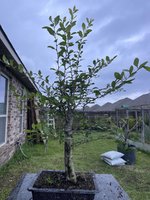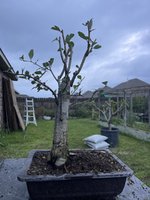You are using an out of date browser. It may not display this or other websites correctly.
You should upgrade or use an alternative browser.
You should upgrade or use an alternative browser.
Species Study - Crataegus aestivalis
- Thread starter Cajunrider
- Start date
Cajunrider
Imperial Masterpiece
So I learned a hard lesson on something I should have known all along. I knew that Mayhaw lumber is very hard when dried. Last weekend I carved a Mayhaw that had a hard chop. About 1/2" of the trunk at the chop has died and dried out. Instead of carving from the top at the chop and going down, I decided to carve from the bottom and went up. Well, the soft live wood allowed my carving bit to go in deeper than it should have. When the bit reached the hard deadwood part, the sudden shift in hardness caused the bit to go out of control & shred my cut resistant glove. The result was multiple cuts on my hand. While the cuts were not deep enough to cause any muscle or tendon damage, they could well have.
The shift in hardness from dead to live wood were quite a bit more than what I experience in bald cypress and pine. It is very much like oaks. Be aware of that when you carve Mayhaw. Always go from hard to soft and not the other way around.
My mayhem Mayhaw row is taking shape. I have a development plan in mind for each of the tree.
The shift in hardness from dead to live wood were quite a bit more than what I experience in bald cypress and pine. It is very much like oaks. Be aware of that when you carve Mayhaw. Always go from hard to soft and not the other way around.
My mayhem Mayhaw row is taking shape. I have a development plan in mind for each of the tree.
Cajunrider
Imperial Masterpiece
Mayhaw trunk split
 www.bonsainut.com
www.bonsainut.com
trunk splitting - lets give it a go...
Been watching plenty Indonesian kinmen videos lately .... Those 3rd world boys have inspired me 🙂... I don't understand one word they say but their results speak louder than all else. I am starting with a fig branch cutting, commiphora (corkwood) stem cutting and a baobab... This process is...
Cajunrider
Imperial Masterpiece
After taking a hard look at all my Mayhaws, I am well pleased. With few exceptions, where the trees still struggle to form roots because I had pruned away too much root at collection, the rest have responded well to bonsai training. They are all either in training mica pot or grow boxes. Wiring of the hawthorn is easy when done at the right time i.e. when the shoots are half-way hardened. The only caution is that the connection between the branch and the trunk easily break off at this time so much care is needed when starting the wiring process at the base of the branch. If a crack occurs at the base of the branch, no matter how I try, the branch does not fare well and usually die.
HorseloverFat
Squarepants with Conkers
G'lawd...
The Murderous Mayhem Mayhaw wall!!!






Looking good, friend!
The Murderous Mayhem Mayhaw wall!!!
Looking good, friend!
HorseloverFat
Squarepants with Conkers
Also, we were speaking of Cratageus in my area. I believe that I may have had the ID's incorrect.
Mostly I see Cratageus Mollis (Downy hawthorn)
And Cratageus Puncata (dotted hawthorn)
But the city PLANTS Cratageus chrysocarpa (Fireberry Hawthorn) on the streets and public properties.

Mostly I see Cratageus Mollis (Downy hawthorn)
And Cratageus Puncata (dotted hawthorn)
But the city PLANTS Cratageus chrysocarpa (Fireberry Hawthorn) on the streets and public properties.
Cajunrider
Imperial Masterpiece
I’ve learned that Crataegus tend to grow multiple branches at each spot. If I remove all but one and then try to wire that one branch, I often break it during wiring. I now will wire the branch I select and then prune the unwanted branches once the wiring for the entire tree is done. This learning is a valuable lesson for me.
Cajunrider
Imperial Masterpiece
BIG OOPS.
Based on my friend's recollection of the seedlings he bought, my Mayhaw trees may be Crataegus opaca instead of Crataegus aestivalis.
Based on my friend's recollection of the seedlings he bought, my Mayhaw trees may be Crataegus opaca instead of Crataegus aestivalis.
Joe Dupre'
Omono
Very interesting thread.
A little tidbit I found on the Internet. The Mayflower ship ( yes, THAT Mayflower) is named after the hawthorn of Europe, whose flowers traditionally bloom in May.
A little tidbit I found on the Internet. The Mayflower ship ( yes, THAT Mayflower) is named after the hawthorn of Europe, whose flowers traditionally bloom in May.
namnhi
Masterpiece
Good morning Uncle, am asking for a refund along with all the suffering this has caused.BIG OOPS.
Based on my friend's recollection of the seedlings he bought, my Mayhaw trees may be Crataegus opaca instead of Crataegus aestivalis.
Cajunrider
Imperial Masterpiece
Cajunrider
Imperial Masterpiece
I spent quite a bit of time lately checking out the Mayhaws groves at my friend's land. Aside from profuse small branch development, the trunks themselves are growing slowly. I am told the trees I collected are 23+ years old. When I first got into the species, I did not appreciate the trunk size as much as I do now. The Mayhaws I have on hand will be the only ones I got. Collecting them in the future is really not readily available. I am going to hang on to the couple dozens I have.
Unlike BCs that can be developed in short order, these Mayhaws will take their sweet time.
Unlike BCs that can be developed in short order, these Mayhaws will take their sweet time.
Last edited:
namnhi
Masterpiece
@Cajunrider
Hi Uncle,
Do you know what these are? Have you seen it on any of your Mayhaw?
I take no chances so they all trimmed and in the trash can they went.






Hi Uncle,
Do you know what these are? Have you seen it on any of your Mayhaw?
I take no chances so they all trimmed and in the trash can they went.






Cajunrider
Imperial Masterpiece
Those are galls from cedar or quince rust. I haven’t seen them on any of my trees. Yours must have picked it up from near by apple and quince trees.@Cajunrider
Hi Uncle,
Do you know what these are? Have you seen it on any of your Mayhaw?
I take no chances so they all trimmed and in the trash can they went.
View attachment 543970View attachment 543971View attachment 543972View attachment 543973View attachment 543974View attachment 543975
namnhi
Masterpiece
Thanks Uncle. I have plenty of quince and crabapple. Didn't see any last year... this is the first time seeing it. I cut them all off. Will see if they coming back.Those are galls from cedar or quince rust. I haven’t seen them on any of my trees. Yours must have picked it up from near by apple and quince trees.
namnhi
Masterpiece
Quince Rust of Mayhaw
The fungus completes part of its life cycle on the cedar and junipers and part on the mayhaw.
Cajunrider
Imperial Masterpiece
Cajunrider
Imperial Masterpiece
Cajunrider
Imperial Masterpiece
namnhi
Masterpiece
No wonder you been busy lately...
Similar threads
- Replies
- 13
- Views
- 401
- Replies
- 6
- Views
- 1K

























